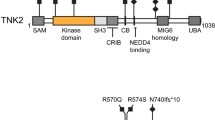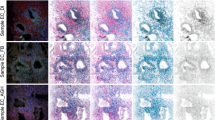Abstract
Objective
TO identify specific tyrosine kinases that are involved in endometrial signaling and to study their in vivo expression in normal and abnormal endometrium. We hypothesized that proteins that are differentially expressed would be more likely to be important in regulated cellular events.
Methods
Complementary DNA libraries, constructed from human secretory (n = 5) and proliferative (n = 5) endometrial specimens, were screened with a polyclonal anti-phosphotyrosine antibody. Positive clones were sequenced and screened for differential expression using immunoblotting and Northern analysis of samples from proliferative and secretory endometrium. The expression of one identified clone, lyn, a Src family member, was characterized further with Western and Northern blot analyses and immunolocalization.
Results
One protein identified by the above method was lyn, a member of the src family of protein tyrosine kinases, never before described in the human endometrium. Western blot analysis revealed two forms of lyn protein, p53lyn and p56lyn, that were most abundant in the late secretory phase. Immunohistochem-istry demonstrated uniform protein expression by all cells in normal glandular epithelium and suggested a correlation between lyn protein expression and cell differentiation for human endometrial adenocarcinomas, with markedly elevated levels noted in poorly differentiated adenocarcinomas compared with well-differentiated tumors (n = 3). Northern hybridization confirmed the presence of the expected 3.5-kb lyn transcript in normal and abnormal endometrium.
Conclusions
Our data demonstrate that human cDNA libraries created from different phases of the menstrual cycle can be screened successfully using anti-phosphotyrosine antibodies to identify differentially expressed protein tyrosine kinases. Although p53lyn and p56lyn expression has been thought of as a predominantly lymphoid-specific tyrosine kinase, we show prominent expression of lyn protein and mRNA by normal and malignant epithelium if the human endometrium, suggesting a role in endometrial signaling and human reproduction.
Similar content being viewed by others
References
Anonymous. Cancer statistics 1995. CA 1995;45:12.
Murphy LJ. Growth Actors and steroid hormone action in endometrial cancer [Review]. J Steroid Biochem Mol Biol 1994;48:419–23.
Hanks SK, Quinn AM, Hunter T. The protein kinase family: Conserved features and deduced phylogeny of the catalytic domains [Review]. Science 1988;241:42–52.
Pavvson T, Hunter T. Oncogenes and cell proliferation. Editorial overview: Signal transduction and growth control in normal and cancer cells. Curr Opin Genet Dev 1994;4:1–4.
Noyes RW, Hertig AT, Rock J. Dating the endometrial biopsy. Am J Obstet Gynecol 1975;122:262–3.
Chomczynski P, Sacchi N. Single-step method of RNA isolation by acid guanidinium thiocyanate-phenol-chloroform extraction. Anal Biochem 1987;162:156–9.
Silverberg SG, Kurman RJ. Tumor classification. In: Silverberg SG, Kurman RJ, eds. Tumors of the uterine corpus and gestational trophoblastic disease. Washington, DC: Armed Forces Institute of Pathology, 1992:13.
Anonymous. Announcement, FIGO stages: 1988 revision. Gynecol Oncol 1989;35:125–6.
Sambrook J, Fritsch EF, Maniatis T. Molecular cloning: A laboratory manual. Cold Spring Harbor. New York: Cold Spring Harbor Laboratory, 1989.
Brickell PM. The p60c-src family of protein-tyrosine kinases: Structure, regulation, and function [Review]. Crit Rev Oncog 1992:3:401–46.
Kefalas P, Brown TR, Brickell PM. Signalling by the p60c-src family of protein-tyrosine kinases [Review]. Int J Biochem Cell Biol 1995;27:551–63.
Tsukita S, Oishi K, Akiyama T, Yamanashi Y, Yamamoto T. Specific proto-oncogenic tyrosine kinases of src family are enriched in cell-to-cell adherens junctions where the level of tyrosine phosphorylation is elevated. J Cell Biol 1991;113:867–79.
Stanley E, Ralph S, McEwen S, et al. Alternatively spliced murine Iyn mRNAs encode distinct proteins. Mol Cell Biol 1991;11:3399–406.
Gordon JI, Duronio RJ, Rudmck DA, Adams SP, Gokel GW. Protein N-myristoylation [Review]. J Biol Chem 1991:266:8647–50.
Yamanashi Y, Mori S, Yoshida M, et al. Selective expression of a protein-tyrosine kinase, p56lyn, in hematopoietic cells and association with production of human T-cell lymphotropic virus type I. Proc Natl Acad Sci U S A 1989;86:6538–42.
Yamashita T, Mao SY, Metzger H. Aggregation of the high-affinity IgE receptor and enhanced activity of p53/561yn protein-tyrosine kinase. Proc Natl Acad Sci USA 1994;91:11251–5.
Yamanashi Y, Kakiuchi T, Mizuguchi J, Yamamoto T, Toyoshima K. Association of B cell antigen receptor with protein tyrosine kinase Lyn. Science 1991;251:192–4.
Siyanova EY, Serfas MS, Mazo IA, Tyner AL. Tyrosine kinase gene expression in the mouse small intestine. Oncogene 1994;9: 2053–7.
Hildebrand JD, Schaller MD, Parsons JT. Identification of sequences required for the efficient localization of the focal adhesion kinase, pp125FAK, to cellular focal adhesions. J Cell Biol 1993;123:993–1005.
Marth JD, Overell RW, Meier KE, Krebs EG, Perlmutter RM. Translational activation of the Ick proto-oncogene. Nature 1988;332:171–3.
Garcia FU, Chen H-L, Yang Y, Pace JL, Hu X-L, Hunt JS. Tumor necrosis factor-α mRNA and protein in endometrial tumors: Analysis by in situ hybridization and immunohistochem-istry. Hum Pathol 1994;25:1324–31.
Author information
Authors and Affiliations
Rights and permissions
About this article
Cite this article
Couchman, G.M., Bentley, R., Tsao, MS. et al. p53lyn and p56lyn: A New Signaling Pathway in Human Endometrium and Endometrial Adenocarcinomas. Reprod. Sci. 4, 103–109 (1997). https://doi.org/10.1016/S1071-5576(97)00011-7
Published:
Issue Date:
DOI: https://doi.org/10.1016/S1071-5576(97)00011-7




